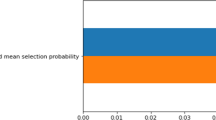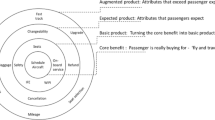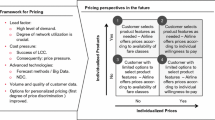Abstract
There is an increasing interest within the travel industry in better understanding customer behavior, particularly the way customers choose between itinerary alternatives when searching for flights. Such an understanding can help travel providers (e.g., airlines) adapt better to market conditions and customer needs, thus increasing their revenue. In this paper, we deal with the problem of modeling air passenger choice between flight itineraries. We describe a two-stage approach to predict travelers’ choice behavior by combining machine learning and discrete choice-modeling techniques. The applicability of these models is then illustrated by employing them for dynamic pricing optimization. We conduct experiments on a dataset extracted from searches and bookings on several European markets, aiming at assessing both the accuracy of our customer models and the effect of price optimization. The proposed approach seems to be effective on both dimensions: (a) improved accuracy when predicting choice, and (b) increased expected revenue of shopping sessions. The experiments show that 42 percent of actual choices fall within the three highest estimated probabilities among 50 alternatives in each shopping session. Moreover, the results also show more than 20 per cent of additional revenue compared with a baseline approach.










Similar content being viewed by others
References
Auria, L. and Moro, R. (2008) Support vector machines (SVM) as a technique for solvency analysis, discussion papers, German Institute for Economic Research, No. 811.
Ben-Akiva, M. and Lerman, S.R. (1985) Discrete choice analysis: Theory and application to travel demand. Cambridge, MIT Press
Bhadra, D. and Hogan, B. (2005) Us airline network: A framework of analysis and some preliminary results. Agifors Symposium.
Carrier, E. (2008) Modeling the choice of an airline itinerary and fare product using booking and seat availability data. Cambridge, Massachusetts Institute of Technology.
Cascetta, E. (2009) Transportation systems analysis. Berlin, Springer.
Coldren, G. and Koppelman, F.S. (2005a) Modeling the competition among air-travel itinerary shares: Gev model development. Transportation Research Part A 39(4): 345–365.
Coldren, G. and Koppelman, F.S. (2005b) Modeling the proximate covariance property of air travel itineraries along the time-of-day dimension. Trans-Portation Research Record 1915: 11–223.
Coldren, G.M., Koppelman, F.S., Kasturirangan, K. and Mukherjee, A. (2003) Modeling aggregate air-travel itinerary shares: Logit model development at a major u.s. airline. Journal of Air Transport Management 9(6): 36–169
Collins, A. and Thomas, L. (2014) Learning competitive dynamic airline pricing under different customer models. Journal of Revenue and Pricing Management 12(5): 416–430 .
Cortes, C. and Vapnik, V. (1995) Support-vector networks. Machine Learn-ing 20: 273–297
Dai, J.G., Ding, W., Kleywegt, A., Wang, X. and Zhang, Y. (2014) Choice based revenue management for parallel ights. Available at SSRN: http://ssrn.com/abstract=2404193, 10.2139/ssrn.2404193.
Garrow, L.A. (2010) Discrete choice modelling and air travel demand. New York, Ashgate Publishing Limited.
Gallego, G., Ratliff, R. and Shebalov, S. (2014) A general attraction model and sales-based linear program for network revenue management under customer choice. Operations Resarch 63: 212–232
Lemp, J.D., Kockelman, K.M. and Damien, P. (2010) The continuous crossnested logit model: Formulation and application for departure time choice. Transportation Research Part B 44(5): 646–661.
Newman, J.P., Ferguson, M.E., Garrow, L.A. and Jacobs, T.L. (2014) Estimation of choice-based models using sales data from a single firm. Manufacturing & Service Operations Management 16(2): 184–197.
Roger A. Parker, Richard Lonsdale, F. E. Z. Z. (2005) The Boeing global market allocation system. Agifors Symposium .
Talluri, K. and van Ryzin, G. (2004) Revenue management under a general discrete choice model of consumer behavior. Management Science 50: 15–33
Train, K.E. (2003) Discrete choice methods with simulation. Cambridge, Cambridge University Press.
Vinod, B., Narayan, C.P. and Ratliff, R.R. (2009) Pricing decision support: Optimising fares in competitive markets. Journal of Revenue and Pricing Manage-ment 8(4): 295–312.
Author information
Authors and Affiliations
Corresponding author
Rights and permissions
About this article
Cite this article
Delahaye, T., Acuna-Agost, R., Bondoux, N. et al. Data-driven models for itinerary preferences of air travelers and application for dynamic pricing optimization. J Revenue Pricing Manag 16, 621–639 (2017). https://doi.org/10.1057/s41272-017-0095-z
Revised:
Published:
Issue Date:
DOI: https://doi.org/10.1057/s41272-017-0095-z




